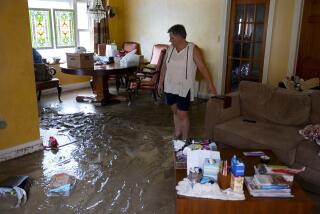A Double Whammy for Wide Swath of the U.S.
WASHINGTON — A major winter storm coated a wide swath of the East Coast in ice Tuesday, closing the federal government, shutting schools and courts, stopping trains and knocking out electric power.
Another low-pressure system layered snow across the Midwest and Great Lakes. Up to 27 inches of snow was possible in northern Michigan by this morning, forecasters said.
The two systems were converging over the Northeast, threatening Pennsylvania, New Jersey, New York, Connecticut, Rhode Island and Massachusetts with heavy ice and snow today. The National Weather Service posted winter storm warnings for the region.
Dozens of deaths were blamed on the storms, most from traffic accidents on icy roads.
The U.S. government sent its Washington, D.C., employees home three hours early Tuesday.
Amtrak canceled four East Coast trains, including the New York-to-Miami runs, because of ice on switches and electrical connections.
Tuesday’s session of Delaware’s Legislature was canceled. Most schools, courts and businesses in Virginia were closed, as were schools in Maryland. Many New Jersey school districts also canceled classes Tuesday. New York was closing schools today because of the weather.
“I don’t like it at all,” said Gisselle Garcia of Newark, N.J., as she waited for a train because roads were too slippery for her to drive. “It’s too cold. My toes get frozen. It’s not safe for kids to be outside. And old people slip and fall on the ice. Enough!”
In the Midwest, snow and sleet fell across Michigan, Indiana, Illinois and Wisconsin. Dozens of Illinois school districts called off classes because of slippery roads. Rush-hour traffic was snarled in Chicago, and hundreds of flights were canceled. Farther west, heavy snow fell in eastern Oregon, Idaho and across the mountains of Montana.
Bitter sub-zero cold, along with high winds swooping in behind the storm in the Midwest, added to the misery and reduced the effectiveness of road salting.
Nantucket Island, off Massachusetts, was frozen in, with ferries canceled and supplies running low.
Public transit systems were especially hard hit, as ice collected on elevated tracks at outdoor stations. Like commuters brushing off their cars, workers for Metro, the Washington area’s subway system, had to scrape ice from stairs and railings.
In North Carolina, Lt. Mike Williams of the Cary Police Department told Raleigh’s WRAL-TV: “These are some of the worst roads I’ve seen in 12 years. It’s 100% like an ice hockey rink.”
Motorists stranded on North Carolina roads swamped emergency operations centers with calls, and parts of Interstate 95, the main East Coast artery, were closed at times because of disabled trucks. North Carolina Gov. Michael F. Easley urged residents to stay home and not to drive unless it was absolutely necessary.
Towing services had plenty of work helping truckers and pulling cars out of ditches.
“People don’t slow down for nothing,” said Peter Ashenden of Lizard Lick Towing & Recovery, near Wendell, N.C.
More than 250,000 customers lost power Tuesday in South Carolina, about 30,000 in North Carolina and 58,000 in Georgia, utilities reported.
More to Read
Sign up for Essential California
The most important California stories and recommendations in your inbox every morning.
You may occasionally receive promotional content from the Los Angeles Times.










